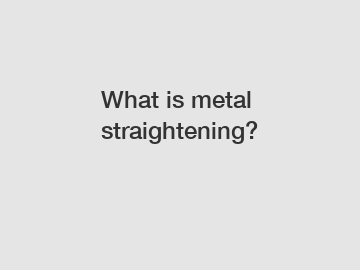What is metal straightening?
Metal straightening is a process used to remove bends, twists, warping, or any other distortions from metal parts or components. This process is typically performed to ensure that the metal part meets the required specifications and tolerances for its intended use. Metal straightening can be done through various methods such as heat straightening, mechanical straightening, or hydraulic straightening.
Step 1: Assessment
The first step in metal straightening is to assess the extent of the distortion in the metal part. This can be done by visually inspecting the part or using measurement tools to determine the amount of distortion present.
Step 2: Choose the appropriate method
Once the extent of the distortion is identified, the next step is to choose the appropriate method for metal straightening. Heat straightening involves applying heat to the distorted area to allow it to be reformed. Mechanical straightening uses specialized tools such as presses or hammers to manually straighten the metal part. Hydraulic straightening involves using hydraulic pressure to straighten the metal part.
Step 3: Prepare the metal part
Before straightening the metal part, it is important to prepare it by cleaning off any debris or contaminants that may interfere with the straightening process. This will ensure a successful straightening process and prevent any damage to the metal part.
Step 4: Straighten the metal part
Depending on the chosen method, proceed to straighten the metal part. If using heat straightening, apply heat to the distorted area and use appropriate tools to straighten it. For mechanical straightening, use presses or hammers to manually straighten the metal part. In hydraulic straightening, apply hydraulic pressure to straighten the metal part.
Step 5: Verify straightness
After straightening the metal part, it is important to verify its straightness using measurement tools. This will ensure that the metal part meets the required specifications and tolerances for its intended use.
Step 6: Final inspection
Once the metal part has been straightened and verified, perform a final inspection to ensure that the straightening process was successful. This may involve visual inspection, measurements, or any other method to confirm the straightness of the metal part.By following these steps, metal straightening can effectively remove distortions from metal parts and ensure that they meet the required specifications for their intended use.
If you want to learn more, please visit our website Precision Pole Straightening Machine, Wire Measuring and Cutting Machine, Wire Guide Price China.
Featured content:Top 5 Reasons Why Yuchai YC80 Excavator is the Perfect Small MachineWhat are the 11 Excavator Bucket Types?Screw press | toolKey Questions to Ask When Ordering Excavator Rake For SaleWHAT IS AN AMPHIBIOUS EXCAVATOR? - YUTANIElectroplating - Chemistry LibreTextsWhat kinds of steel bar straightening machines are there?
Featured content:Efficiency Unveiled: How Vacuum CVD Systems Revolutionize Coating ApplicationsBlow Molding Machine Buying GuideHow does a liquid packaging machine work?The Inner Workings of a Production Freeze DryerWhat is the temperature of a vibrating screen bearing?How does spark plasma sintering work?What is PCB Labeling Machine

All Comments ( 0 )